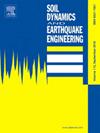Intensity-dependent site amplification factors using non-linear ground response analysis for Greater Srinagar Metropolitan in the deep sedimentary basin of Kashmir
IF 4.2
2区 工程技术
Q1 ENGINEERING, GEOLOGICAL
引用次数: 0
Abstract
This paper includes 1D nonlinear site-response analyses at 154 sites in key geological deposits of the Kashmir Valley, North-Western Himalayas. Responses to a suite of 22 motions of varying intensity (peak accelerations ∼0.01 g–0.86 g) from global and regional records were studied, using the entire depth to geological bedrock for the sedimentary deposits. Acceleration response spectra and amplification factors (AFs) were proposed for different geomorphological units of the region. Rock sites showed AF ≈ 1 for long periods (>1 s), and 1–1.5 for shorter periods (<1 s) at all intensities. Deep sedimentary sites had AFs as large as 2.76 for low-intensity motions, and as low as 0.11 for high-intensity motions. Short-period factor, Fa, was lower (∼0.29–2.32) compared to the long-period factor, Fv, for the deep deposits. This indicates that seismic codes underestimate response at long periods in deep soil deposits, which could cause undesirable seismic performance of tall buildings.
求助全文
约1分钟内获得全文
求助全文
来源期刊

Soil Dynamics and Earthquake Engineering
工程技术-地球科学综合
CiteScore
7.50
自引率
15.00%
发文量
446
审稿时长
8 months
期刊介绍:
The journal aims to encourage and enhance the role of mechanics and other disciplines as they relate to earthquake engineering by providing opportunities for the publication of the work of applied mathematicians, engineers and other applied scientists involved in solving problems closely related to the field of earthquake engineering and geotechnical earthquake engineering.
Emphasis is placed on new concepts and techniques, but case histories will also be published if they enhance the presentation and understanding of new technical concepts.
 求助内容:
求助内容: 应助结果提醒方式:
应助结果提醒方式:


